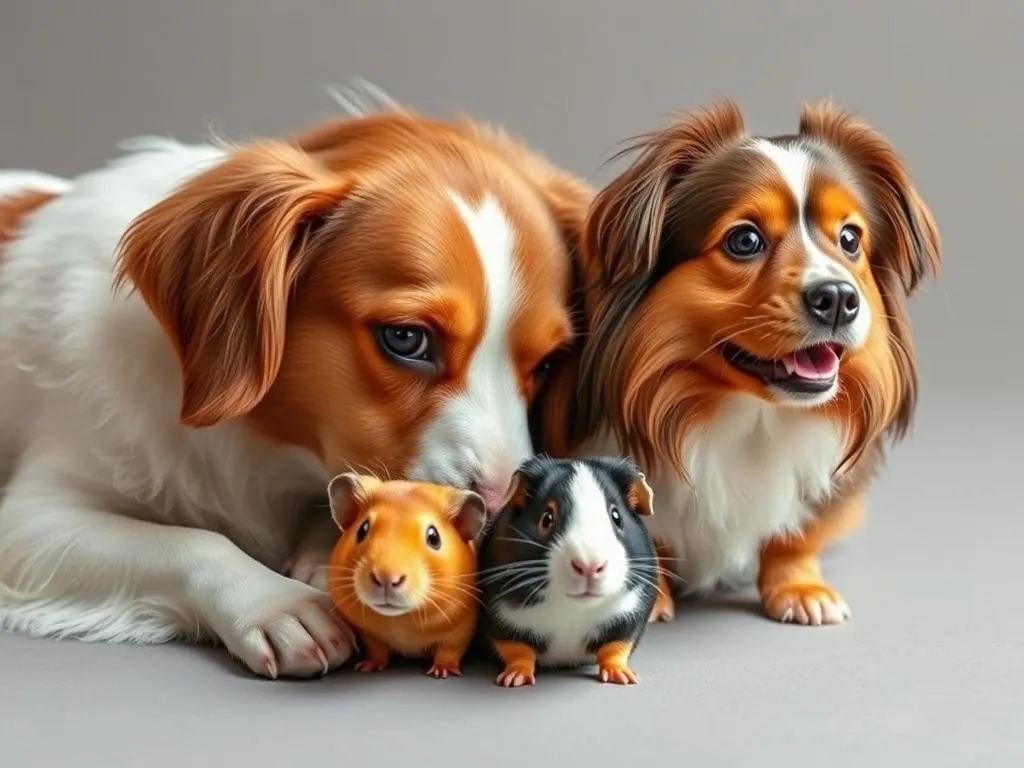
Introduction
When it comes to raising pets, many animal lovers often wonder about the dynamics of interspecies relationships. One common question that arises is: do dogs and guinea pigs get along? Understanding the compatibility between different species is crucial for ensuring a harmonious household, especially as dogs and guinea pigs are both popular pets.
This article aims to explore the compatibility between these two animals, providing insights into their behaviors, safety tips for interactions, and the importance of responsible pet ownership. As we delve deeper into this topic, we’ll uncover valuable information that can help pet owners make informed decisions regarding their furry family members.
Understanding Dog Behavior
Types of Dog Breeds
The temperament of dogs can greatly influence their interactions with smaller animals like guinea pigs. Some dog breeds are known for their gentle disposition and low prey drive, making them more suitable companions for guinea pigs. Breeds such as Golden Retrievers, Labrador Retrievers, and Cavalier King Charles Spaniels are typically good with smaller animals due to their friendly nature.
On the other hand, certain breeds may have a high prey drive, which can pose a threat to guinea pigs. Breeds like Terriers, Hounds, and Herding breeds often exhibit strong instincts to chase smaller animals. Understanding the breed characteristics is crucial for assessing whether your dog might coexist peacefully with a guinea pig.
Key Behavioral Traits
Dogs are social animals with unique behavioral traits that can affect their interactions with other species. Their socialization tendencies can dictate how they react to new animals in their environment. A well-socialized dog is generally more adaptable and less likely to exhibit aggressive or overly excited behavior around smaller pets.
However, instinctual behaviors, such as chasing and guarding, can surface, especially in breeds with a strong prey drive. Recognizing these traits early will help you prepare for potential challenges when introducing your dog to a guinea pig.
Training and Management
Training plays a vital role in managing a dog’s behavior. Positive reinforcement techniques can help modify unwanted behaviors and promote calm interactions. Teaching commands like “leave it” or “gentle” can significantly improve the likelihood of successful engagements between dogs and guinea pigs.
Additionally, consistent management of interactions is essential. Keeping the dog on a leash during initial introductions can help maintain control and prevent any sudden movements that might frighten the guinea pig.
Understanding Guinea Pig Behavior
Social Nature of Guinea Pigs
Guinea pigs are inherently social creatures that thrive on companionship, whether with their own kind or sometimes even with other species. They are known to express distress when isolated, making it essential for them to have a buddy, whether that be another guinea pig or a friendly dog.
Understanding stress signals, such as rumbling, whimpering, or hiding, is crucial for monitoring their well-being during interactions. If a guinea pig exhibits these signs, it’s essential to intervene and assess the situation immediately.
Communication Methods
Guinea pigs communicate through a variety of vocalizations and body language. Sounds such as wheeking, chirping, or squeaking can indicate happiness, fear, or even discomfort. Learning to interpret these signals can help pet owners determine when a guinea pig feels safe or threatened.
Observing their body language is equally important. Signs of comfort include relaxed posture and exploring their surroundings, while signs of fear may involve freezing, crouching, or trying to escape. Recognizing these cues can make a significant difference in ensuring safe interactions with dogs.
Safety Needs
Creating an ideal environment for guinea pigs is essential to their safety and happiness. They require a secure space where they can retreat if they feel threatened. Unlike dogs, guinea pigs are not naturally inclined to defend themselves, making it necessary to provide them with adequate shelter to hide and feel secure.
Understanding their instincts and vulnerabilities is paramount. They should be housed in areas away from high-traffic zones where a dog could unintentionally startle them.
Compatibility Factors
Initial Introductions
When considering whether dogs and guinea pigs get along, the initial introduction is crucial. It should always take place in a controlled environment, where both animals feel secure. A neutral space, such as a room separate from the dog’s usual territory, can help reduce territorial aggression.
Gradual introductions are key. Start by allowing the dog to observe the guinea pig from a distance, rewarding calm behavior with treats. This method helps both animals acclimate to each other’s presence without overwhelming either party.
Assessing Individual Personalities
Compatibility between a dog and a guinea pig largely depends on their individual personalities. Factors such as age, temperament, and previous experiences with other animals can influence how well they interact.
For example, a calm, older dog may respond better to a guinea pig than an excitable puppy. Additionally, recognizing red flags during introductions, such as excessive barking or aggressive postures from the dog, is crucial for assessing compatibility.
Observing Interactions
Monitoring interactions closely is vital for identifying signs of a positive relationship. Look for behaviors such as the dog being calm around the guinea pig, and the guinea pig displaying relaxed body language. These signals indicate a budding friendship.
Conversely, signs of stress or aggression, such as growling, lunging, or hiding, should not be ignored. If any negative behaviors arise, it’s essential to separate the animals immediately and reassess the approach to introductions.
Tips for Safe Interactions
Supervised Meetings
Supervision is essential during initial interactions between dogs and guinea pigs. Never leave them alone together until you are entirely confident in their relationship. Start with short meetings, gradually increasing the duration as both animals become more comfortable.
Frequent, brief interactions are often more beneficial than longer sessions, as they can help prevent overwhelming either pet and reduce stress.
Creating Safe Spaces
Designing a safe area for guinea pigs is crucial for their protection. Utilize barriers, such as baby gates or playpens, to create a secure space where the guinea pig can feel safe while still being able to observe the dog.
Ensure that the guinea pig’s cage is sturdy and escape-proof. This provides a safe retreat if the dog’s presence becomes too overwhelming.
Training the Dog
Training the dog to exhibit calm behavior around guinea pigs is essential for fostering a peaceful coexistence. Commands such as “sit,” “stay,” and “leave it” can help control the dog’s impulses.
Using positive reinforcement techniques, such as treats and praise, can encourage good behavior during interactions. Consistent training reinforces positive associations with the guinea pig, reducing the likelihood of aggressive or overly excited reactions.
Case Studies and Personal Experiences
Success Stories
There are many heartwarming success stories of dogs and guinea pigs forming unlikely friendships. For example, a family adopted a calm Labrador Retriever who quickly befriended their two guinea pigs. The dog learned to approach them gently, while the guinea pigs grew comfortable enough to explore around him.
Lessons learned from these experiences often highlight the importance of gradual introductions, patience, and training. Such success stories serve as inspiration for pet owners contemplating the addition of a guinea pig to their household.
Cautionary Tales
While there are numerous success stories, cautionary tales also exist. Some pet owners have shared experiences where their dog’s prey drive resulted in negative outcomes for their guinea pig. In one instance, an untrained Terrier chased a guinea pig, leading to injury.
Analyzing what went wrong in these situations often reveals a lack of proper training, supervision, or understanding of each animal’s instincts. These cautionary tales underscore the importance of responsible pet ownership and the need for thorough preparation before introducing new pets.
Alternatives for Pet Owners
Considerations for Pet Selection
If you are concerned about do dogs and guinea pigs get along, it may be wise to consider alternative pets that coexist well with dogs. Small animals like rabbits or certain breeds of cats might be more suitable companions for dogs, depending on the individual animals’ temperaments.
Resources for Pet Owners
Pet owners seeking guidance can benefit from a variety of resources. Books, websites, and professional trainers offer valuable insights into animal behavior and training techniques. Consulting with a veterinarian or animal behaviorist can also provide personalized advice tailored to your specific pets.
Community Support
Engaging with online forums and local pet groups can offer additional support and shared experiences from fellow pet owners. These communities can provide a wealth of knowledge and encouragement for those navigating the complexities of multi-species households.
Conclusion
In summary, understanding whether dogs and guinea pigs get along involves careful consideration of their behaviors, personalities, and the environment in which they interact. Through responsible pet ownership, training, and supervision, it is possible to foster a harmonious relationship between these two species.
By staying informed and proactive, pet owners can ensure a safe and loving home for all their furry companions, allowing for a unique and enriching multi-species household. The journey may require patience and vigilance, but the rewards of seeing your pets coexist can be truly fulfilling.









